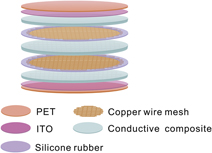Crossref Citations
This article has been cited by the following publications. This list is generated based on data provided by
Crossref.
Wang, Luheng
2016.
Pressure sensing material based on piezoresistivity of graphite sheet filled silicone rubber composite.
Sensors and Actuators A: Physical,
Vol. 252,
Issue. ,
p.
89.
Huang, Bin
Wang, Xiaomeng
Li, Chengwei
Yi, Jiajing
Lu, Rongsheng
and
Tao, Jiayue
2016.
Development and calibration of an air-floating six-axis force measurement platform using self-calibration.
Review of Scientific Instruments,
Vol. 87,
Issue. 9,
Huang, Ying
Wang, Yue
Gao, Le
He, Xiaoyue
Liu, Ping
and
Liu, Caixia
2017.
Characterization of stretchable SWCNTs/Lycra fabric electrode with dyeing process.
Journal of Materials Science: Materials in Electronics,
Vol. 28,
Issue. 5,
p.
4279.
Guo, Xiaohui
Huang, Ying
Wu, Can
Mao, Leidong
Wang, Yue
Xie, Zhicheng
Liu, Caixia
and
Zhang, Yugang
2017.
Flexible and reversibly deformable radio-frequency antenna based on stretchable SWCNTs/PANI/Lycra conductive fabric.
Smart Materials and Structures,
Vol. 26,
Issue. 10,
p.
105036.
Ali, Asar
Khan, Adam
Ali, Amjad
and
Ahmad, Mushtaq
2017.
Pressure-sensitive properties of carbon nanotubes/bismuth sulfide composite materials.
Nanomaterials and Nanotechnology,
Vol. 7,
Issue. ,
p.
184798041770708.
Guo, Xiaohui
Huang, Ying
Zhao, Yunong
Mao, Leidong
Gao, Le
Pan, Weidong
Zhang, Yugang
and
Liu, Ping
2017.
Highly stretchable strain sensor based on SWCNTs/CB synergistic conductive network for wearable human-activity monitoring and recognition.
Smart Materials and Structures,
Vol. 26,
Issue. 9,
p.
095017.
Wang, Luheng
Zhu, Yachen
Lv, Dandan
and
Wang, Fei
2018.
Effects of multi experimental cycles on pressure/gap-impedance characteristic of coil made of carbon black filled silicone rubber composite.
Sensors and Actuators A: Physical,
Vol. 272,
Issue. ,
p.
281.
Zhu, Hongqiu
Wang, Fei
Wang, Luheng
and
Wang, Yalin
2018.
Influences of compression cycles on piezocapacitive effect of carbon black filled silicone rubber composite.
Sensors and Actuators A: Physical,
Vol. 271,
Issue. ,
p.
192.
Bai, Lu
Li, Zhongxiao
Zhao, Shizhen
and
Zheng, Junping
2018.
Covalent functionalization of carbon nanotubes with hydroxyl-terminated polydimethylsiloxane to enhance filler dispersion, interfacial adhesion and performance of poly(methylphenylsiloxane) composites.
Composites Science and Technology,
Vol. 165,
Issue. ,
p.
274.
Wang, Luheng
2018.
Compressive capacitance relaxation of carbon black filled silicone rubber composite.
Polymer Composites,
Vol. 39,
Issue. 10,
p.
3446.
Liu, Caixia
Wu, Can
Hao, Chao
Liu, Ping
Guo, Xiaohui
Zhang, Yugang
and
Huang, Ying
2018.
Electrical conductivity transformation mechanism of GNPs/CB/SR nanocomposite foams.
Journal of Applied Polymer Science,
Vol. 135,
Issue. 11,
Slobodian, Petr
Riha, Pavel
Olejnik, Robert
Matyas, Jiri
and
Kovar, Michal
2018.
Poisson effect enhances compression force sensing with oxidized carbon nanotube network/polyurethane sensor.
Sensors and Actuators A: Physical,
Vol. 271,
Issue. ,
p.
76.
Ali, Asar
Khan, Adam
Karimov, Kh. S.
Ali, Amjad
and
Daud Khan, Adnan
2018.
Pressure Sensitive Sensors Based on Carbon Nanotubes, Graphene, and Its Composites.
Journal of Nanomaterials,
Vol. 2018,
Issue. ,
p.
1.
Huang, Ying
Zhang, Jinyuan
Pu, Jiangfan
Guo, Xiaohui
Qiu, Jihong
Ma, Yuanming
Zhang, Yugang
and
Yang, Xiaoming
2018.
Resistive pressure sensor for high-sensitivity e-skin based on porous sponge dip-coated CB/MWCNTs/SR conductive composites.
Materials Research Express,
Vol. 5,
Issue. 6,
p.
065701.
Yellapantula, Kartik
Devaraj, Harish
Assadian, Mahtab
Stuart, Logan
Lo, Cheng-Yao
Gan, Wee Chen
and
Aw, Kean
2020.
Soft and flexible sensor array using carbon black pillars for object recognition via pressure mapping.
Measurement,
Vol. 159,
Issue. ,
p.
107781.
Huang, Ying
Wang, Yang
Sun, Xuehu
Guo, Xiaohui
Zhang, Yangyang
Wang, Zhiqiang
Liu, Ping
Liu, Caixia
Qiu, Jihong
and
Zhang, Yugang
2020.
Superelastic and large-range pressure sensor with hollow-sphere architectures for wearable electronic skin.
Smart Materials and Structures,
Vol. 29,
Issue. 4,
p.
045014.
He, Yin
Zhao, Liduan
Wang, Xiujuan
Liu, Liyan
and
Liu, Hao
2020.
Microstructured hybrid nanocomposite flexible piezoresistive sensor and its sensitivity analysis by mechanical finite-element simulation.
Nanotechnology,
Vol. 31,
Issue. 18,
p.
185502.
Jang, Daeik
Farooq, S.Z.
Yoon, H.N.
and
Khalid, H.R.
2021.
Design of a highly flexible and sensitive multi-functional polymeric sensor incorporating CNTs and carbonyl iron powder.
Composites Science and Technology,
Vol. 207,
Issue. ,
p.
108725.
Nabeel, Mohammed
Varga, Miklós
Kuzsela, László
Filep, Ádám
Fiser, Béla
Viskolcz, Béla
Kollar, Mariann
and
Vanyorek, László
2021.
Preparation of Bamboo-Like Carbon Nanotube Loaded Piezoresistive Polyurethane-Silicone Rubber Composite.
Polymers,
Vol. 13,
Issue. 13,
p.
2144.
Panda, Subhadra
and
Acharya, Bibhudendra
2021.
PDMS/MWCNT nanocomposites as capacitive pressure sensor and electromagnetic interference shielding materials.
Journal of Materials Science: Materials in Electronics,
Vol. 32,
Issue. 12,
p.
16215.
